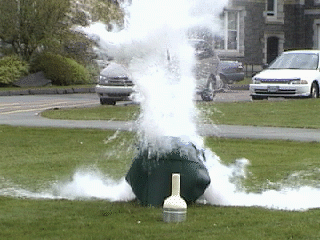Watch what happens when pressure builds to the breaking point!
WATCH THE VIDEO!
DO NOT DO THIS YOURSELF!
 |
 |
 |
|
Exploding Erasers |
Supercooling Balloon in Nitogen |
How to Make a Water Rocket |
Teachable Topics:
- pressure
- contained energy release
- work - energy
Theory:
Much of what we know today about heat and temperature came from studies of Gases by Boyle, Gay-Lussac, Charles and others in the 19th century. Their studies utilized an idealized model for real gases that have sufficiently low densities so that the gas molecules are far enough apart so they do not interact (except for collisions which are assumed to be elastic). This "Ideal Gas Law" relates the absolute pressure, the Kelvin temperature, the volume and the number of molecules of the gas.
The Ideal gas Law can be summarized by the following equation:
where:
- P is the absolute pressure of the gas
- V is the volume occupied by the gas,
- n is the number of molecules of gas,
- R is the universal gas Constant = 8.31 J/(mol*K)
- T is the Kelvin temperature of the gas.

Figure 1: Pressure built-up inside the garbage can
It can be seen from the Ideal Gas Law that if the volume and the number of gas molecules is kept constant then:
P is proportional to T, (constant V and n)
So an increase in temperature will increase the pressure of a gas, or a decrease in temperature will result in a decrease in the pressure.
The pressure (P) of a gas is an important idea in physics, and is a consequence of molecules colliding with the walls of their container. These collisions each exert a force on the walls of the container and the velocities (speeds and directions) of the molecules are randomized. In a macroscopic sample of gas containing many, many molecules, this randomness ensures that the forces on the container's walls are distributed evenly. The average total force on the container's walls (F), divided by the area (A) of the container is the pressure of the gas.
P = F/A
The ratio of the force (F) to the area (A) is commonly referred to as Stress. If the pressure in a vessel (pop bottle in this case) exceeds the maximum stress that the vessel was designed to withstand then the vessel will fail by rupturing and blowing apart.
Apparatus:
- plastic garbage can
- liquid nitrogen
- 2 L pop bottle with screw on cap
- 5 Kg mass
- hot water
Procedure:
- Don't do this! Just watch the darn video!
- Set up a plastic trash can outside, and far away from any one, or thing.
- Fill the trash can with warm water, until it is about four inches from the top.
- Tape a weight (at least 5 Kg) on the bottom of a 2L pop bottle.
- Then fill the pop bottle with approximately 300 ml of liquid nitrogen.
- Quickly place the top on the bottle tightly, then toss in the trash can filled with warm water, and run!
SAFETY WARNINGS:
- This is an extremely dangerous demo, so take every safety precaution (LIKE NOT DOING IT!).
- Make sure the weight is firmly attached to the bottom of the pop bottle before you throw it into the trash can and drop the bottle with the weighted end first into the garbage can.
- Liquid Nitrogen can be substituted with chunks of dry ice, however both are potentially harmful so be careful & don't touch either directly.
- DO NOT PERFORM THIS EXPERIMENT IN UNSUPERVISED CONDITIONS!!



